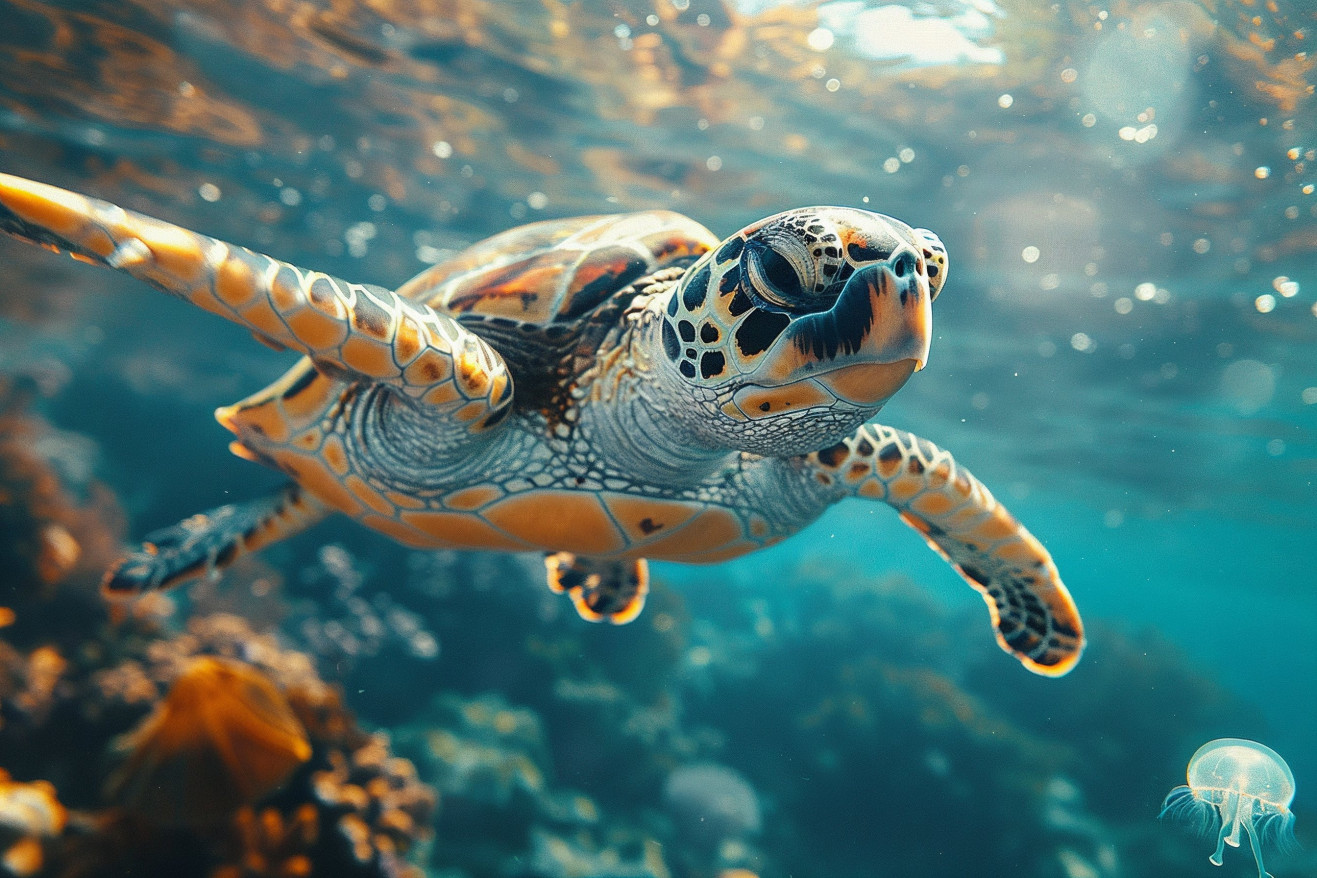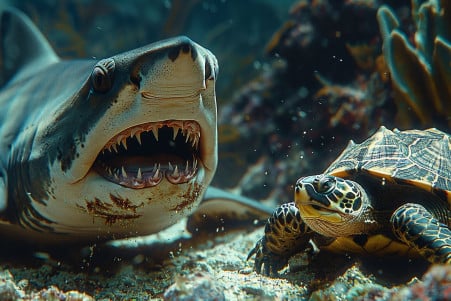Do Jellyfish Get Turtles High? Debunking Marine Myths
10 March 2024 • Updated 9 March 2024

Turtles eat jellyfish, but do they get more than they bargained for when they chow down on these marine animals? The short answer is no. There is no scientific evidence to suggest that jellyfish get turtles high. Turtles eat jellyfish as part of their regular diet and do not experience any psychoactive effects. Claims that jellyfish have a psychoactive effect on turtles are not based on any evidence and are completely false.
In this article, we will draw on the fields of marine biology and toxinology to shed light on the relationship between turtles and their gelatinous prey. We will take a closer look at the feeding behaviors of sea turtles, marine neurotoxins, and the interactions between jellyfish and their predators.
Through a review of scientific research and interviews with experts, we will explain the impact of jellyfish consumption on turtles, dispel myths, and hopefully deepen your understanding of these amazing marine animals.
Do jellyfish get turtles high?
Unpacking Sea Turtle Diets: The Jellyfish Factor
Sea turtles, and leatherbacks in particular, are gelatinivores because of their strong preference for jellyfish, including lion’s mane and moon jelly species. The Turtle Conservation Society of Malaysia reports that leatherbacks can eat jellyfish in quantities that equal up to 73% of their body weight, which is the fuel they need for their long migrations.
They have even evolved anatomical adaptations like scales and throat papillae to protect them from jellyfish stings and help them eat these gelatinous animals.
The nutritional value of jellyfish to sea turtles is also shown by a video from National Geographic that shows a green sea turtle eating jellyfish tentacles. This indicates that jellyfish are a significant part of the diet of juvenile green sea turtles as well.
In addition, changes in the environment may have caused a decline in sea grass, which is a more traditional food source, and contributed to the turtles’ increased consumption of jellyfish.
It’s important to note that while jellyfish are part of the sea turtles’ diet, there’s no evidence that eating jellyfish has any kind of psychoactive effect on the animals. This dispels any myths and confirms that the turtles are eating jellyfish for sustenance, not to get high.
Understanding the Effects of Marine Neurotoxins
Some marine animals, such as jellyfish, produce powerful marine neurotoxins that can impact the nervous systems of marine animals and humans alike. According to a paper in Clinical Autonomic Research, these venoms cause “profound disruption of human autonomic functions,” leading to symptoms like vasospasm and cardiac irregularities by disrupting ion transport and creating pores in cell membranes.
Jellyfish use their nematocyst-loaded venom to sting, which is used for both defense and prey capture. While these toxins are dangerous to humans, causing painful stings and even death, their impact on sea turtles is quite different. A paper in Clinical Autonomic Research and a study on PubMed show that the same toxins that can be so harmful to humans have no effect on turtles.
Sea turtles have evolved over millions of years to develop biological adaptations that protect them from the neurotoxins in jellyfish. These adaptations ensure that jellyfish are a safe and nutritious part of their diet.
By learning more about these toxins and the physiological differences between humans and turtles, we can understand why marine venoms don’t impact turtles the way they do humans, which can help to debunk myths and show the importance of marine science in separating truth from fiction.
Jellyfish and Turtle Defenses
Jellyfish have evolved a complex defense system, and while their stinging cells are mainly used as a defense mechanism, they are also used to capture prey. Nematocysts are the cells that make stinging possible, and they can shoot out of the jellyfish at high speeds, according to a study in eLife, but they are only good for one shot before they have to be regenerated.
This means that jellyfish have to be selective about when they use their stings, and they have to use them in a way that is both defensive and predatory.
Jellyfish stings serve two purposes in the ecosystem: they help jellyfish catch their prey and protect them from predators. The upside-down jellyfish, which a team of researchers described in JSTOR Daily, releases mucus that contains nematocysts into the water, which helps them both catch their prey and protect themselves.
Sea turtles, especially leatherbacks, have evolved ways to get around these defenses. Their skin is thick, and they have structures in their throats, like papillae, that help them eat jellyfish without being stung.
The idea that the defensive toxins in jellyfish have a narcotic effect on turtles is a myth. Because of these adaptations, turtles can eat jellyfish without the stinging effects that deter other marine animals, making jellyfish a safe part of their diet.
How Sea Turtles’ Senses Work
Sea turtles rely on a range of senses to successfully navigate the ocean. In addition to taste and touch, sea turtles also have highly developed chemosensory systems.
According to the Bycatch Management Information System, which focuses on research to help reduce bycatch, studies of sea turtles’ sensory biology have shown that these animals have a highly evolved sensory system that allows them to interact with their environment in ways that are essential for their survival and ability to find food.
The State of the World’s Sea Turtles (SWOT) explains that sea turtles have good vision, although it has a “slow” temporal resolution and low acuity, which is well-suited to the bright environment in which they live.
They also have a high sensitivity to low-frequency sounds, which is consistent with the underwater environment. Sea turtles are also sensitive to chemical cues in the water, including dimethyl sulfide, which can help them find food from a distance, a skill that’s especially important since they feed on jellyfish.
In addition, they use the Earth’s magnetic field to help them navigate over long distances, a system that’s similar to the GPS.
When it comes to eating jellyfish, sea turtles’ neurological responses to these stimuli are highly specific, allowing them to hunt effectively without experiencing any psychoactive effects. In The Sensory Biology of Sea Turtles, John A. Musick explains that sea turtles use throat-pumping to increase their ability to smell, a trait that’s necessary for finding jellyfish.
The complex way that sea turtles’ sensory and nervous systems are set up doesn’t support the idea that jellyfish cause sea turtles to get high. Instead, sea turtles’ reactions to the jellyfish they eat are based on their need to survive, not to get high. This scientific fact underscores the importance of learning about animals like sea turtles through research and observation rather than relying on myths and legends.
The Truth About Sea Turtles and Jellyfish: Debunking the Myths
In conclusion, our exploration of the fascinating feeding relationship between sea turtles and jellyfish has made one thing abundantly clear: there is no scientific evidence to support the idea that jellyfish consumption has psychoactive effects on sea turtles.
As noted by AP News, experts like jellyfish researcher Monty Graham and Sea Turtle Conservancy’s David Godfrey have pointed out that any psychoactive effects would interfere with the turtles’ basic survival needs.
A comprehensive investigation of marine neurotoxins, the sensory biology of sea turtles, and prey-predator interactions has shown that sea turtles have successfully adapted to their jellyfish prey without any psychoactive effects, despite what social media may claim.
The importance of this study goes beyond debunking myths. It underscores the importance of understanding marine biology and ecology based on scientific evidence. By thinking critically and turning to science, we can gain a deeper understanding of the nuances of marine ecosystems and the need to conserve them.
By summarizing the evidence and reiterating scientific facts, this article aims to help readers appreciate the wonder and complexity of the natural world without the distortions of myth. The well-being and survival of sea turtles, which are essential to the health of the world’s oceans, rely on our knowledge and caring.


